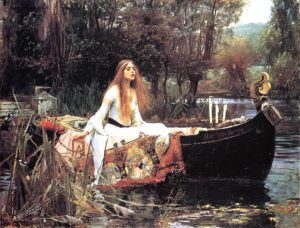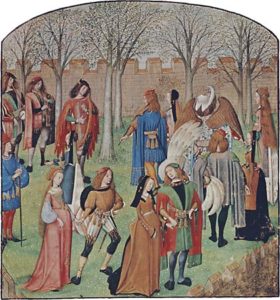Fan fiction has really taken off in recent years, especially with the success (relatively speaking) of several fan fiction stories that became novels and even movies. Fan fiction is a tricky kind of writing because you often have to immerse yourself in someone’s world to write about it. And it’s also tricky because of potential copyright issues, but the general rule of thumb is that if you’re not using a character to mock him or her or completely deconstruct the world in which that person is put by the original author, then you’re not doing extreme harm. Fan fiction is tough to publish because of fair use being pulled beyond its limits, but we can’t be stopped from writing stories in which we wax poetic about people we admire. And fan fiction can produce some amazing writing. But let’s extend this idea to thinking about the genre of historical fiction, which often puts famous people into fiction for specific purposes and/or uses famous settings for new stories.
The Prompt
Write a story about your favorite pop culture icon or your favorite time period.
Tips
• In May, despite not knowing as much as I should about Doctor Who, I used him as a character in a short story. I wanted to have some fun with time travel, and Doctor Who made the most sense for that. I write a lot of historical fiction because I love to briefly insert famous people or famous situations into my stories. I love watching World War II films because I like to learn about what people did while wars waged in other parts of the world or even just a few miles from where a film is set.
• Who’s your pop culture crush? Maybe someone from a British drama, such as Orphan Black or Downton Abbey? Maybe someone more domestic based on where you live? Or maybe you have a famous or somewhat unknown setting in which you’d love to write a story?
• Try as best as you can to be authentic with what this person does or what happens in this setting. Sure, you could put cell phones and the Internet into Downton Abbey, and you could have Sherlock Holmes have a Southern accent, but will your readers appreciate these changes or will it unnerve them? Sometimes, you can’t worry about readers when trying to express yourself, but you have to understand that killing off everyone’s favorite pop culture icon is going to upset people more than entertain them.
• If you feel like putting several famous people into your story, do it. Of course, if you put people from different time periods or settings into your story, you might want to explain how that’s possible. And don’t always rely on time travel. Consider another way to express this idea without using tried and true methods. This is your chance to create something new.
• You’ll have many chances this month to write fun and entertaining stories. Make the most of your passion about someone you admire and adore by making us feel like we’re right there in your story. This is where taking time to research comes in handy. The Internet is your friend.
Let’s do this—and have fun!
Post a comment to the blog to let us know what you wrote about (including linking to your story on your own site or elsewhere) and/or join the community and post in the Victory Dance group.
Christopher Stolle is a professional book editor and sometimes writer. You can find his stories for this month at https://storiesbystolle.wordpress.com, and you can find some of his recent poems at https://www.facebook.com/stolle.poems. He has published dozens of poems in several countries, and he has written two nonfiction books for Coaches Choice: 101 Leadership Lessons From Baseball’s Greatest Managers (2013) and 101 Leadership Lessons From Basketball’s Greatest Coaches (2015). He finds inspiration in cooking, taking long walks, and ASMR videos. He lives in Richmond, Indiana—the cradle of recorded jazz.



